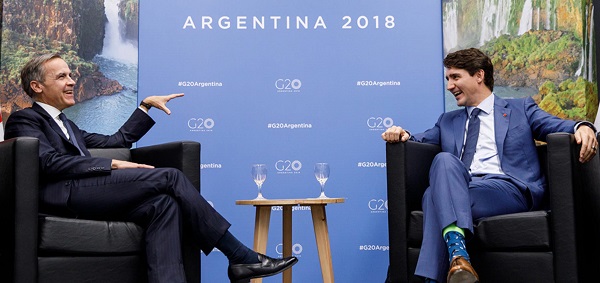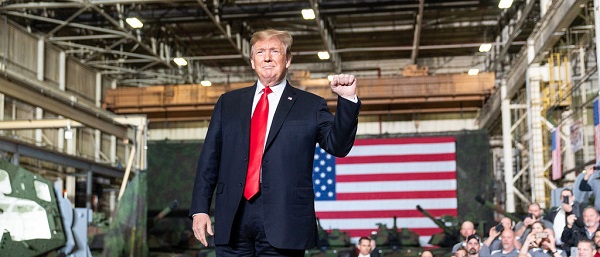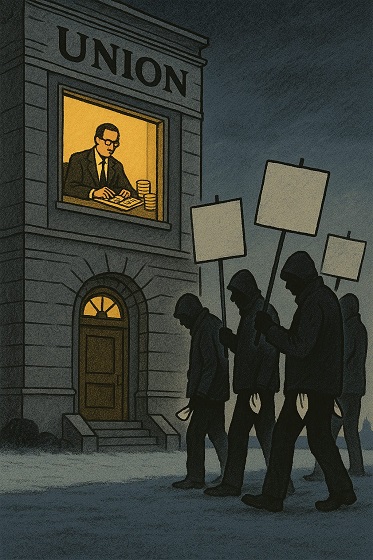Business
There are smart ways to diversify our exports

From the Fraser Institute
By Philip Cross
The Bank of Canada recently cut interest rates again, with further cuts likely in response to Donald Trump’s threat to impose tariffs on Canadian exports. This continues the Bank’s reflexive turn to lower interest rates to goose growth every time the economy slows that began during the 2008 global financial crisis and reached its apex during the outbreak of the Covid pandemic when rates essentially hit their zero lower bound.
It’s time policymakers in Ottawa stop relying on easy money policies in response to every hiccup in economic growth. Lower interest rates have introduced major distortions into Canada’s economy. They have fueled excessive debt levels in all sectors of the economy, helped to create a housing bubble that will depress growth when it bursts, undermined our consensus on the usefulness of immigration when excessive demand raised the cost of shelter, and led youths to lose hope of achieving the dream of owning a home. Housing’s unsustainably large share of our economy helps undermine our potential productivity, the lack of which Bank of Canada Deputy Governor Carolyn Rogers last year called a “break the glass” emergency. However, the Bank’s own easy money policies spurs the shift of more resources to housing and encourage governments to ignore taking actions that would boost business investment and exports, the two sectors needed to improve our long-term productivity and competitiveness.
There are policy alternatives to just mechanically lowering interest rates and juicing housing demand. The silver lining in Trump’s tariff threats is they drive home to Canadians the twin follies of not diversifying our energy exports from the U.S. market and not lowering internal barriers to trade among our provinces. We witlessly ignored opportunities to move on both fronts for nearly a decade after Trump fired his opening salvo in the trade war with punitive tariffs on our aluminum and steel industries in 2017.
Energy, our leading export, depends on the U.S. market for 93 per cent of its export earnings. Canada has wasted numerous opportunities over the past decade to open overseas markets for oil and gas. The Trudeau government cancelled the Northern Gateway pipeline that would have sent Alberta crude to Asia. The proposed Energy East pipeline to send oil to New Brunswick and ultimately Europe floundered after the federal government complicated the approval process. Multiple proposals for LNG projects were rejected, although the Quebec government is reconsidering its opposition to ship natural gas from an LNG terminal in Saguenay to Europe. Quebec is not reflexively against pipelines: its former Premier Jean Charest boasts how his government oversaw one connecting crude oil imports landing at Levis to refineries in Montreal by clearly outlining the benefits to Quebecers. Restricting our oil and gas exports to the U.S. has depressed their prices, costing Canada tens of billions of dollars of lost revenue and betraying our European allies when they desperately needed alternatives to Russian natural gas supplies following its attack on Ukraine.
Meanwhile, the federal government displayed little leadership in trying to get the provinces to reduce the thicket of regulations and restrictions that impair trade within Canada. The 2017 Canada Free Trade Agreement provided a road map to potentially lower internal trade barriers, but most provinces have been reluctant to tread that path. It is the height of hypocrisy for Canadians to complain about Trump’s threatened tariffs when we tolerate internal trade barriers that are every bit as important and costly to our economy. Statistics Canada, for example, found that trade within Canada moves as if there were a 7 per cent tariff on goods moving between provinces, while trade within the U.S. flows as if there was no effective tariff.
The shock and outrage Canadians are expressing about Trump’s pending 25 per cent tariff on most exports can be channeled to our benefit. Achieving that will require governments to stop our dangerous over-reliance on low interest rates to stimulate housing. Instead, the focus should be improving our access to markets outside the U.S., which are clearly viable and profitable for goods such as oil and gas. Furthermore, if we truly believe our own rhetoric about the benefits of trade, we need to take concrete steps to liberalize trade within Canada.
Business
Canada is failing dismally at our climate goals. We’re also ruining our economy.

From the Fraser Institute
By Annika Segelhorst and Elmira Aliakbari
Short-term climate pledges simply chase deadlines, not results
The annual meeting of the United Nations Conference of the Parties, or COP, which is dedicated to implementing international action on climate change, is now underway in Brazil. Like other signatories to the Paris Agreement, Canada is required to provide a progress update on our pledge to reduce greenhouse gas (GHG) emissions by 40 to 45 per cent below 2005 levels by 2030. After decades of massive government spending and heavy-handed regulations aimed at decarbonizing our economy, we’re far from achieving that goal. It’s time for Canada to move past arbitrary short-term goals and deadlines, and instead focus on more effective ways to support climate objectives.
Since signing the Paris Agreement in 2015, the federal government has introduced dozens of measures intended to reduce Canada’s carbon emissions, including more than $150 billion in “green economy” spending, the national carbon tax, the arbitrary cap on emissions imposed exclusively on the oil and gas sector, stronger energy efficiency requirements for buildings and automobiles, electric vehicle mandates, and stricter methane regulations for the oil and gas industry.
Recent estimates show that achieving the federal government’s target will impose significant costs on Canadians, including 164,000 job losses and a reduction in economic output of 6.2 per cent by 2030 (compared to a scenario where we don’t have these measures in place). For Canadian workers, this means losing $6,700 (each, on average) annually by 2030.
Yet even with all these costly measures, Canada will only achieve 57 per cent of its goal for emissions reductions. Several studies have already confirmed that Canada, despite massive green spending and heavy-handed regulations to decarbonize the economy over the past decade, remains off track to meet its 2030 emission reduction target.
And even if Canada somehow met its costly and stringent emission reduction target, the impact on the Earth’s climate would be minimal. Canada accounts for less than 2 per cent of global emissions, and that share is projected to fall as developing countries consume increasing quantities of energy to support rising living standards. In 2025, according to the International Energy Agency (IEA), emerging and developing economies are driving 80 per cent of the growth in global energy demand. Further, IEA projects that fossil fuels will remain foundational to the global energy mix for decades, especially in developing economies. This means that even if Canada were to aggressively pursue short-term emission reductions and all the economic costs it would imposes on Canadians, the overall climate results would be negligible.
Rather than focusing on arbitrary deadline-contingent pledges to reduce Canadian emissions, we should shift our focus to think about how we can lower global GHG emissions. A recent study showed that doubling Canada’s production of liquefied natural gas and exporting to Asia to displace an equivalent amount of coal could lower global GHG emissions by about 1.7 per cent or about 630 million tonnes of GHG emissions. For reference, that’s the equivalent to nearly 90 per cent of Canada’s annual GHG emissions. This type of approach reflects Canada’s existing strength as an energy producer and would address the fastest-growing sources of emissions, namely developing countries.
As the 2030 deadline grows closer, even top climate advocates are starting to emphasize a more pragmatic approach to climate action. In a recent memo, Bill Gates warned that unfounded climate pessimism “is causing much of the climate community to focus too much on near-term emissions goals, and it’s diverting resources from the most effective things we should be doing to improve life in a warming world.” Even within the federal ministry of Environment and Climate Change, the tone is shifting. Despite the 2030 emissions goal having been a hallmark of Canadian climate policy in recent years, in a recent interview, Minister Julie Dabrusin declined to affirm that the 2030 targets remain feasible.
Instead of scrambling to satisfy short-term national emissions limits, governments in Canada should prioritize strategies that will reduce global emissions where they’re growing the fastest.

Elmira Aliakbari
Artificial Intelligence
Lawsuit Claims Google Secretly Used Gemini AI to Scan Private Gmail and Chat Data

Whether the claims are true or not, privacy in Google’s universe has long been less a right than a nostalgic illusion.
|
When Google flipped a digital switch in October 2025, few users noticed anything unusual.
Gmail loaded as usual, Chat messages zipped across screens, and Meet calls continued without interruption.
Yet, according to a new class action lawsuit, something significant had changed beneath the surface.
We obtained a copy of the lawsuit for you here.
Plaintiffs claim that Google silently activated its artificial intelligence system, Gemini, across its communication platforms, turning private conversations into raw material for machine analysis.
The lawsuit, filed by Thomas Thele and Melo Porter, describes a scenario that reads like a breach of trust.
It accuses Google of enabling Gemini to “access and exploit the entire recorded history of its users’ private communications, including literally every email and attachment sent and received.”
The filing argues that the company’s conduct “violates its users’ reasonable expectations of privacy.”
Until early October, Gemini’s data processing was supposedly available only to those who opted in.
Then, the plaintiffs claim, Google “turned it on for everyone by default,” allowing the system to mine the contents of emails, attachments, and conversations across Gmail, Chat, and Meet.
The complaint points to a particular line in Google’s settings, “When you turn this setting on, you agree,” as misleading, since the feature “had already been switched on.”
This, according to the filing, represents a deliberate misdirection designed to create the illusion of consent where none existed.
There is a certain irony woven through the outrage. For all the noise about privacy, most users long ago accepted the quiet trade that powers Google’s empire.
They search, share, and store their digital lives inside Google’s ecosystem, knowing the company thrives on data.
The lawsuit may sound shocking, but for many, it simply exposes what has been implicit all along: if you live in Google’s world, privacy has already been priced into the convenience.
Thele warns that Gemini’s access could expose “financial information and records, employment information and records, religious affiliations and activities, political affiliations and activities, medical care and records, the identities of his family, friends, and other contacts, social habits and activities, eating habits, shopping habits, exercise habits, [and] the extent to which he is involved in the activities of his children.”
In other words, the system’s reach, if the allegations prove true, could extend into nearly every aspect of a user’s personal life.
The plaintiffs argue that Gemini’s analytical capabilities allow Google to “cross-reference and conduct unlimited analysis toward unmerited, improper, and monetizable insights” about users’ private relationships and behaviors.
The complaint brands the company’s actions as “deceptive and unethical,” claiming Google “surreptitiously turned on this AI tracking ‘feature’ without informing or obtaining the consent of Plaintiffs and Class Members.” Such conduct, it says, is “highly offensive” and “defies social norms.”
The case invokes a formidable set of statutes, including the California Invasion of Privacy Act, the California Computer Data Access and Fraud Act, the Stored Communications Act, and California’s constitutional right to privacy.
Google is yet to comment on the filing.
|
|
|
|
Reclaim The Net is reader-supported. Consider becoming a paid subscriber.
|
|
|
|
-

 Uncategorized2 days ago
Uncategorized2 days agoCost of bureaucracy balloons 80 per cent in 10 years: Public Accounts
-

 Daily Caller1 day ago
Daily Caller1 day agoDemocrats Explicitly Tell Spy Agencies, Military To Disobey Trump
-

 Addictions2 days ago
Addictions2 days agoActivists Claim Dealers Can Fix Canada’s Drug Problem
-

 Alberta2 days ago
Alberta2 days agoEdmonton and Red Deer to Host 2027 IIHF World Junior Hockey Championship
-

 Carbon Tax2 days ago
Carbon Tax2 days agoCarney fails to undo Trudeau’s devastating energy policies
-

 Daily Caller1 day ago
Daily Caller1 day agoALAN DERSHOWITZ: Can Trump Legally Send Troops Into Our Cities? The Answer Is ‘Wishy-Washy’
-

 Alberta23 hours ago
Alberta23 hours agoAlberta on right path to better health care
-

 Alberta2 days ago
Alberta2 days agoAlbertans choose new licence plate design with the “Strong and Free” motto












